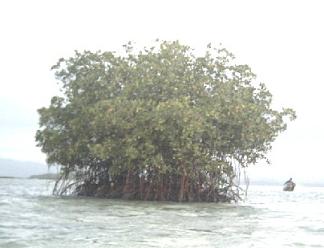
 |
|
|
|---|
| Coastal ecosystems commonly encountered in Sumatra are mangroves, beach vegetation on accreting coasts, beach vegetation on abrading coasts, brackish water forests, rocky shores and coral reefs. |

|
|---|
Whitten et al. (1996) document dramatic changes in the accretion of parts of the Sumatran coastline, indicating that both Jambi and Palembang had been ports at the end of promontories about 1000 years ago, and speculate on the crucial role of mangroves in coastal accretion.

The most commercially valuable mangrove related species is the paenaeid prawns, which supports an export market worth $150 million annually (Anon 1979). Conversion of mangroves to tambak fish ponds is the major factor in the destruction of the mangrove communities, particularly in eastern Sumatra. Turner (1977) also observed that the conversion of mangroves to tambak is commercially unprofitable and would lead to a loss of jobs. To indicate this, Turner (op. cit.) showed that the average coastal tambak produces 287 kg of fish/ha/yr, which is more than the offshore shrimp yield, but the loss of one hectare of tambak actually leads to an approximate net loss of 480 kg/ha/yr of offshore fish and shrimp per year.
On accreting coasts, there are a wide variety of sand binding, salt tolerant, hardy herbs, grasses and sedges (Whitmore 1984), inhabited by adapted assemblages of crabs and crustaceans. These coasts are also used as nesting sites for Green Turtles, the eggs of which are commonly sold in Padang; Hawksbill Turtles in the region of Sibolga; and the rarer Leatherback Turtle at scattered sites. Most concentrations of turtles are on the offshore islands and the west coast of the mainland (Soegiarto and Polunin 1980), but there is little recent confirmation of turtle nesting sites.
Brackishwater forests or Nipa (Nypa fructicans) forests are scattered along the inner boundaries of mangroves. It has only the date palm (Phoenix paludosa) restricted to it.
The coastal environment of West Sumatra consists of a chain of islands and shallow water reefs, separated from the mainland of Sumatra by deep water. The islands extend from Simuelue Island in the north to the Enggano Islands in the southeast. The eastern sides of these islands are, in some places, covered by mangrove. Some coral species are adjacent to the mangrove roots. Further eastward, more corals appear and among the most abundant are massive Porites, which can form minor atolls. They are mostly dominated by coral boulders of Porites and big columns of Goniastea corals. The reef flats are wide, and they slope down gently to 5-10 m depth. The soft bottom substrate coral communities are dominated by various species of Acropora, Seriatopora and Pocillopora.
There are two chains of small islands running parallel to the east coast of Sumatra at a distance of approx 10 km and 30 km, respectively. The inshore chain is located on the continental shelf with a depth around 50-100 m while the outer chain is in the 200 m isobath on the continental slope. The reef flats are narrow and gently sloping down to 10 m depth.
On the western side of the island are spur and groove formations, and the eastern side is well protected from strong wave action. Coral reef communities are subject to heavy sedimentation from the Sumatran rivers. Coral sites surveyed here ranged from good to poor, and 49 genera were noted (Suharsono 1998). Reefs are poorly developed on the northern part of the east coast of Sumatra but are widespread around the offshore island to the south of Riau Kepulauan as far as the islands of Bangka and Belitung. |
|---|
Source : Report on Biodiversity and Tropical Forests in Indonesia, USAID/Indonesia, 2004. Prepared by : (1) Steve Rhee, M.E.Sc. (2) Darrell Kitchener, Ph.D. (3) Tim Brown, Ph.D. (4) Reed Merrill, M.Sc. (5) Russ Dilts, Ph.D. (6) Stacey Tighe, Ph.D. |
 |
 |
|---|
|
|||||||||||||||||||||||||||
|---|---|---|---|---|---|---|---|---|---|---|---|---|---|---|---|---|---|---|---|---|---|---|---|---|---|---|---|
|
|
|||||||||||||||||||||||||||